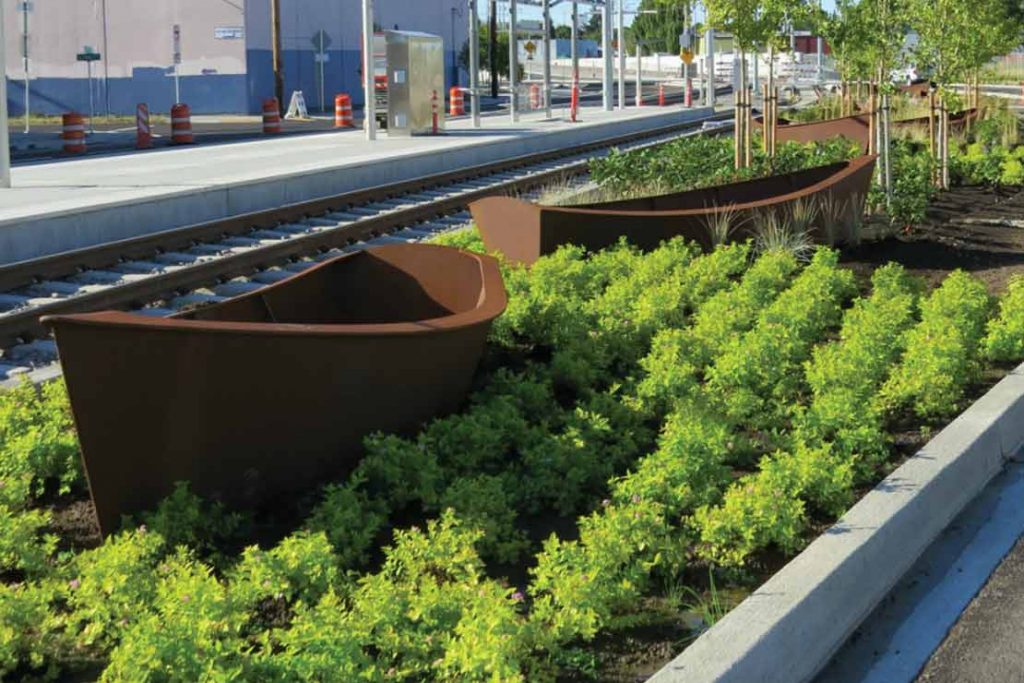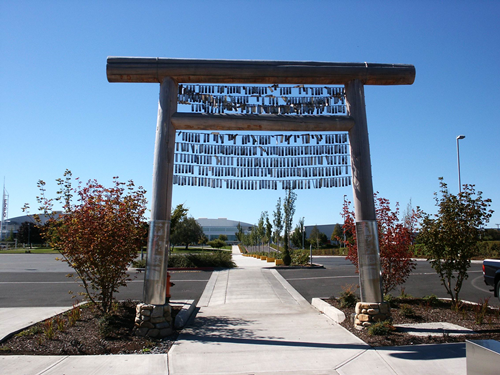Over the past quarter century, TriMet’s Public Art Program has helped provide a sense of place to people on the go
Ride the MAX Orange Line along SE 17th Avenue, and you’ll notice several boats—weathered and rust-colored—that appear to drift down the landscaped median. At Mt. Hood Avenue, one stop before MAX Red Line reaches Portland International Airport, you’ll see a metallic collection of clouds hoisted by legs into the air. Or at Fifth and Sixth Avenues, between Hoyt and Glisan Streets in northwest Portland next to where MAX Green, Orange and Yellow Line trains roll, you’ll pass five stacked stone sculptures of varying heights known as cairns—a type of guiding landmark dating back to prehistoric times.
All across our system, sculptures, murals, mosaics and more give rise to a sense of place, inspire curiosity and spark dialogue. Starting this March, we’re honored to be celebrating the 25th anniversary of the Public Art Program. During those 25 years, the program has commissioned over 250 works of art by 147 artists, all in places where the public can enjoy them.
“Art has a way of communicating our shared humanity, and to that end, public art on our transit system helps humanize what could otherwise be a rather impersonal environment,” said TriMet’s Public Art Administrator Michelle Traver. “All of the artwork on our system was created specifically for where it is, with the intention to help connect riders to where they are and better connect our station areas to the neighborhoods where they exist. It is a great example of one way TriMet shows it cares for and invests in our communities.”
To celebrate the 25th anniversary, TriMet is launching a public-facing portal—an online database that makes it possible to search or browse our entire collection of art: publicart.trimet.org. Check it out and, as you ride, keep an eye out for the various works we’ve installed.
Public Art takes shape
While TriMet’s Public Art Program began taking shape in 1992 with the Westside extension of MAX Blue Line to Hillsboro, TriMet’s Board of Directors formally adopted the program in 1997. It was part of a growing movement among transit agencies across the country, boosted by the Federal Transit Administration, which encouraged and financially supported public art on transit projects.
Since then, TriMet has included public art on rail construction projects with 1.5% of each project’s civil construction budget allocated for most of the art you see at or near our stations today. The program is guided by arts and design professionals, as well as community members who volunteer on our many art advisory committees and help in selecting the artists and artwork.
Reflecting on history and cultures
Successful public art helps create more vibrant, livable places where people want to be, but it can do more than that. Acknowledging and preserving local and regional cultural history has been a priority of TriMet’s Public Art Program. Over the past 25 years, we’ve done that by using art to tell the stories of the communities we serve.
Voices of Remembrance at the Expo Center MAX Station is an example of how public art can connect riders to their environment and acknowledge history. The station at the Expo Center was once a livestock pavilion where in 1942 American citizens of Japanese descent were ordered into captivity as they awaited transfer to long-term internment camps up and down the West Coast.
Designed by late artist Valerie Otani and currently undergoing restoration, Voices of Remembrance features traditional Japanese Torii gates—made of cedar and signifying the entrance to a sacred location. Strung from each of the two gates are hundreds of metal tags in the shape of the identification tags internees had to wear, which sway and clink like chimes. They symbolize the dehumanizing effect of forced relocation. At the station platforms, cast bronze steam trunks represent the improvised seating used by those waiting in long lines, while their identities and documents were “processed.”
At the Delta Park/Vanport MAX Station, remnants from Vanport, the wartime public housing project wiped away in a 1948 flood, are set into the sidewalk. Artifacts from the Chinookan culture, Vanport and the Portland International Raceway are cast into a bronze railing at the platform. Further reflections on the significance of the flooding of Vanport—once home to around 40,000 people, 40% of whom were Black—can be found in glass mosaic community maps on the platform that overlay the current Delta Park site onto the city grid of Vanport. Additionally, roof-shaped steel sculptures in the landscape recall rooftops adrift in floodwaters.
Art for everyone
For 25 years, TriMet has been proud to work with artists, community members and our riders to bring art to the three counties we serve. Most recently, art has been on the move, and that will continue with new bus wrap designs celebrating diversity. They include:
- February: Black History.
- March: National Women’s History
- May: Asian Pacific American Heritage
- September: National Hispanic-Latino Heritage
- November: National American Indian Heritage
Much of the current focus of the Public Art Program is managing and caring for our existing collection. In the year to come, we’ll continue our partnerships with the Regional Arts and Culture Council (RACC) and the Portland Bureau of Transportation, through the Our Town National Endowment for the Arts grant and the Black Portland Art Matters Initiative.
The field of public art is changing, with an even greater emphasis on artists and artwork, including raising the profiles of artists from diverse backgrounds. Public arts helps enhance the experience of our riders and communities, and TriMet is proud of supporting and investing in the art and culture of our region as we look to an even more creative future.








